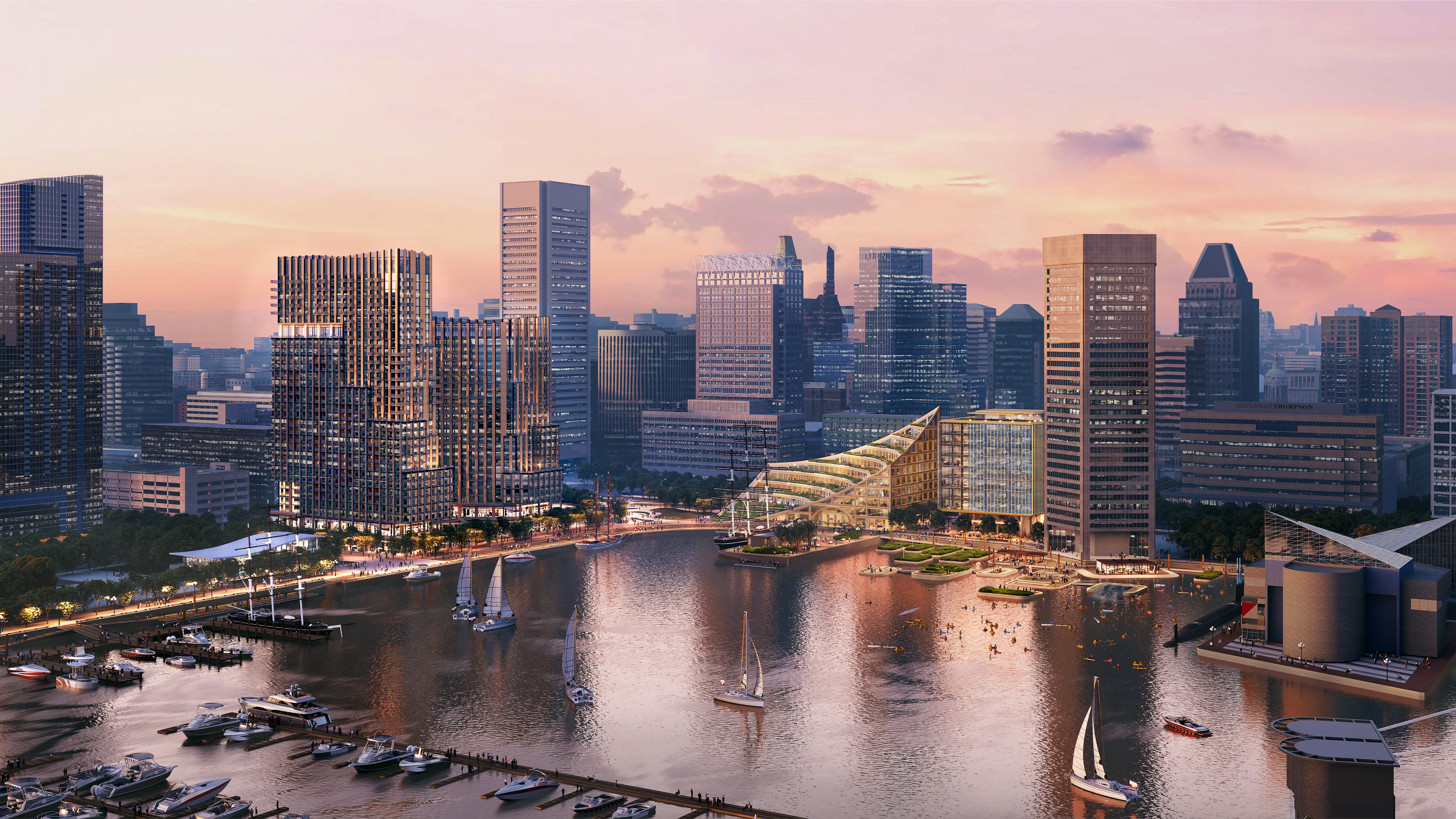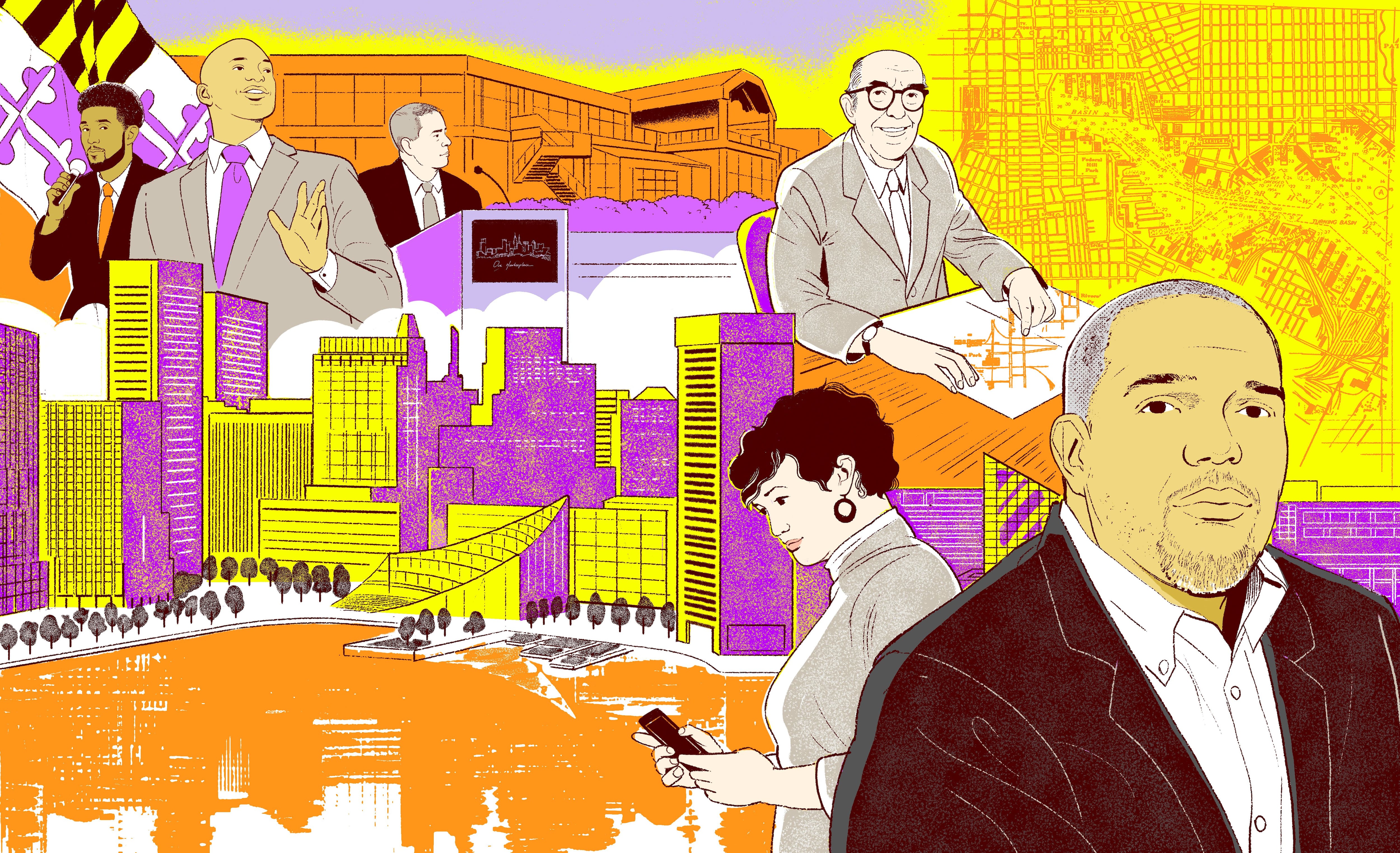Baltimore’s Inner Harbor, once seen as a shining example of urban renewal, is due for a face lift, with the price ballparked at $900 million.
Most of the money to redevelop Harborplace will come from private investors, its developers have said, and they’re asking for about $400 million in public funds — meaning taxpayer dollars. That’s expected to come mainly from state and federal coffers. Still, only a small fraction has been accounted for.
Here’s what we know so far.
Where will the public money come from?
The State of Maryland has approved $67.5 million over three years for the Harborplace project. The city also gave the developer, MCB Real Estate, $1 million to assist with predevelopment costs. That leaves $331.5 million unaccounted for.
The funds will flow through the Waterfront Management Authority, which is overseen by the nonprofit Waterfront Partnership of Baltimore. The partnership and authority receive some city funding to help maintain city property around the Inner Harbor.
P. David Bramble, managing partner of Harborplace developer MCB Real Estate, sat on the authority’s board of directors in 2023. City Council members and an official from the mayor’s office serve on both organizations’ boards.
Read More
Who decides how that money is spent?
The waterfront partnership and authority are the ones responsible for spending the public money for this project, according to Laurie Schwartz, president of the partnership. She said they are dedicated to making sure it’s only spent on public areas like the promenade, the pedestrian walkway and bike path that rims the Inner Harbor.
“The public promenade is 50 years old, and many pieces of it have outlived their useful life. It’s ready for reconstruction, not just renovation or repairs,” she said. “A reconstruction of the promenade, and a redesign, if it’s done well, will make it more inviting and attractive and resilient for decades to come.”
Caroline Hecker, an attorney representing MCB Real Estate, echoed that sentiment at the City Council’s Economic and Community Development Committee hearing last month. She also said that she expects federal funds to help pay for the promenade, too.
This story is part of a deep dive into the future of Harborplace
“The federal government paid for the construction of the promenade when it was originally built 50 years ago. They paid for the major improvements that were made 20 years ago,” she said. “And the expectation is that there will be federal funds to fund the reconstruction, rehabilitation of the promenade.”
Federal Urban Renewal funds were used to completely gut and rebuild the area surrounding the Inner Harbor in the 1960s and ’70s, including the promenade itself.
No ask has been made of the federal government for funds yet, according to the Baltimore City Mayor’s Office.
Developers have stressed that they haven’t asked Baltimore for any funds, though in the current lease agreement between the city and developers, Baltimore agreed to give $1 million for services related to the project, along with waiving rent on the property for the duration of the redevelopment process.
“We are not looking for any city funding for the project,” Hecker said at the hearing.
Hecker said she also expects the state to help pay for some of the infrastructure surrounding the project, including any changes to streets surrounding the development. MCB’s renderings show major changes to Pratt Street, including narrowing the roadway and potentially adding light rail. The renderings also show a narrower Light Street to the west of the harbor, and to remove the spur that currently connects the two streets.
Whether that state money would come out of the $67.5 million approved for the promenade, or whether that would mean additional funding is unclear. These numbers could all change, perhaps even drastically, before it’s all said and done.
“I know that $400 million number has been thrown around,” Hecker said.
Even now in the early stages of the project, the number doesn’t feel solid yet.
How does this compare to other publicly funded projects?
It’s hard to make true comparisons, and there are all sorts of caveats, but no matter what, $400 million is a lot of public money. It’s as much as or more than has been spent on many other big-ticket projects in recent years.
One of the biggest influxes of money into the city in recent years was the American Rescue Plan Act, which injected $641 million into the city. Those funds were divided among several sectors, with the most money — about $180 million — being committed to housing, including building new affordable housing, housing for the homeless and assistance programs for renters and homeowners. Harborplace will use more than twice as much public money as the $180 million ARPA housing budget.
An upgrade to the Howard Street Tunnel, a 1.7-mile tunnel running under Baltimore built in 1895, is expected to cost $466 million, but that’s a combination of federal, state, local and private money. The taller tunnel will allow trains to double-stack containers arriving through the Port of Baltimore, and could give a big boost to its freight capabilities.
The nearby Harbor Point redevelopment used $125 million in public funds in the form of tax increment financing, or TIF bonds. TIF bonds are designed to capture any increase in land value brought on by redevelopment, and have been a common way to get big public projects off the ground in Baltimore. There is no TIF currently planned for the Harborplace development.
Harbor East, another large waterfront redevelopment in Baltimore, also cost in the hundreds of millions, but the amount of public money spent on that project was unclear, with the majority appearing to come from private investors.
Correction: A prior version of this story incorrectly stated that the Waterfront Partnership of Baltimore and the Waterfront Management Authority were primarily privately funded. The largest percentage of the organizations' funding comes through the authority, a business improvement district where property owners pay a surcharge on their properties.
:quality(70)/cloudfront-us-east-1.images.arcpublishing.com/baltimorebanner/B2UKGHPNGVADDG36R6NXHDFGGA.jpeg)


:quality(70)/s3.amazonaws.com/arc-authors/baltimorebanner/106f7ee4-9bba-49eb-b641-b18c9427bfc5.png)
:format(jpg)/cloudfront-us-east-1.images.arcpublishing.com/baltimorebanner/TBZL5637TBERBJ7OFK4HA554UI.png)
:format(jpg)/cloudfront-us-east-1.images.arcpublishing.com/baltimorebanner/GTCCVJZJVNETVJQAABDIYOSCW4.JPG)
:format(jpg)/cloudfront-us-east-1.images.arcpublishing.com/baltimorebanner/C5RNK4UYEZHJ5KRAE5TAXBVZEM.jpg)
:format(jpg)/cloudfront-us-east-1.images.arcpublishing.com/baltimorebanner/SAIF3W6YERGZFPARMH64PQNMEM.jpg)